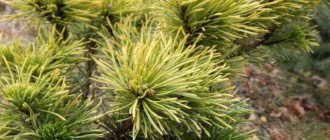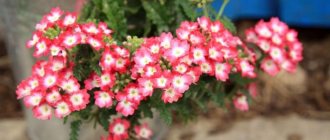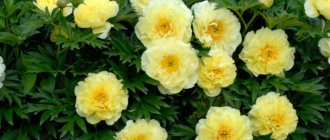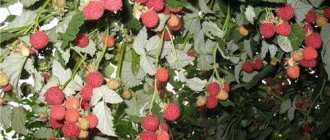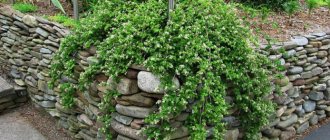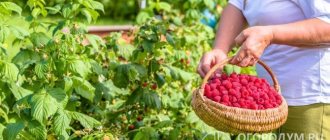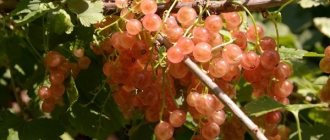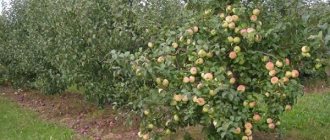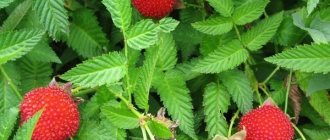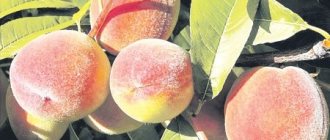Mountain pine Mugus is an ornamental shrub native to the Balkans and the Eastern Alps. The botanical name of the plant is pinus mugo mughus. Owners of private houses fell in love with mountain pine for its unpretentiousness and beauty. The tree is often used in landscape design, as its crown has the ability to take on fancy shapes and decorate the garden area.
Botanical description of the tree
Mountain pine (pinus mugo) is a slow-growing plant. The average growth per year is 10 cm in height and the same in width. The tree is distinguished by a lush pyramidal crown. The trunk is covered with dense brown bark.
The bright green needles are needles collected together in twos. The length of the needles reaches up to 5 cm. The first cones on the Mugus pine appear after seven years of growth. During flowering, cone-shaped orange fruits grow on the branches.
The plant is able to grow in mountainous areas thanks to its strong and powerful roots. In addition, Mugus pine perfectly tolerates lack of moisture and severe frosts. It has strong immunity and rarely becomes a victim of pests.
Description
The Mugus variety is a variety of dwarf mountain pine, bred in 1779. It grows in the mountainous regions of Central and Southern Europe. Under natural conditions, it is a tree that can grow up to meters; in a cultivated form, it is a lush, tall shrub, sometimes reaching 5 meters in height. A description of the appearance of this pine variety will give a more accurate idea of the plant.
- One or more trunks are covered with creeping branches growing vertically. Light green young shoots become stronger over time and acquire a brown color. Heavy snow does not harm the strong branches of the Mugus pine.
- The wide spreading crown of a creeping shape reaches a diameter of 3-4 m.
- The needles are thick, shiny, the needles are arranged tightly in bunches, 4-5 pieces each. In the spring, the tree pleases with its delicate, light, delicate greenery; by autumn, the needles acquire a rich emerald hue. Brown buds up to 6 mm long ripen between the needles. The needles change once every 5-6 years.
- After 6-7 years, golden-brown cone-shaped cones, 5 to 8 cm long, appear on the branches. They give the shrub pine a special charm and make the variety a popular plant in landscape design. And the small dark seeds in the cones can be eaten.
Mughus pine (Pinus mugo Mughus) is a long-liver even compared to its perennial counterparts: under favorable conditions it can live up to 1000 years.
Planting and care
It is recommended to plant pine seedlings in mid-spring. The procedure is carried out before buds appear on the plant. The landing site should be well lit and sunny. However, you need to ensure that shading is formed in the area at midday. This feature will prevent the needles from burning.
Mountain pine is not picky about soil. It grows well in fertile soil and in soil with a minimum amount of nutrients. If a gardener wants his plant to develop quickly, then he should plant it in loamy soil. Sand is added to the ground before planting.
Seedlings for planting are purchased from a nursery. Healthy planting material has a strong above-ground part and bright green needles. To ensure that the seedling is guaranteed to take root, you should choose one- or two-year-old options with closed roots.
Before planting the seedling, the earthen ball is slightly moistened. Specimens with open rhizomes are placed in a bucket of water for 2-2.5 hours.
If the plant has rotten or disease-infected roots, they should be cut off and treated with a fungicidal agent.
Before planting, prepare the planting hole. Its width should be 2 times the diameter of the earthen ball. The bottom of the hole is covered with a drainage layer of broken bricks or pebbles. A mixture consisting of peat, sand, sawdust and turf is poured over the drainage.
After this, the seedling is lowered into the hole and covered with soil from the site. After planting, the plant is watered with two buckets of water. To prevent moisture from quickly evaporating, the soil around the trunk is mounded.
In order for a young seedling to take root as quickly as possible, it will need regular watering. During the first 90 days after planting, the plant is watered once a week. After 3-4 months, watering is reduced to twice a month. Pine trees that have been growing on the site for more than a year are watered only when the top layer of soil dries to a depth of 5-6 cm.
In summer, sprinkling is recommended. This procedure will help improve the decorative properties of pine, as well as protect it from attack by pests.
Mountain pine Mugus is a plant that has a superficial root system. In order not to damage it, the gardener must loosen the soil to a depth of no more than 5 cm. After loosening, hilling must be carried out. Mulching with sawdust will help protect the soil from drying out.
Shrubs can be fed from the age of three. Various preparations are used as fertilizers to improve plant immunity. In the spring, the crop is fed with nitrogen-containing compounds. In summer and autumn, mineral phosphorus fertilizer should be applied. To achieve the best effect, the plant is watered after feeding.
In addition to standard feeding, foliar feeding is carried out on pine trees several times a year. The procedure involves treating the crown with Epin-extra solution.
Sanitary cutting is carried out in early spring. During the procedure, all diseased and frozen branches after winter are removed. In addition, dry shoots growing inside the crown are cut off.
You can develop resistance to frost in mountain pine by providing it with good shelter. Before the onset of cold weather, the seedling is mulched with peat, and then the branches are bent to the center and wrapped in burlap. The trunk is wrapped in film to protect it from rodent infestation. In a few years, the mountain pine will begin to winter independently under the snow.
Landing
When planting, you should consider some nuances:
- The suitable period for planting is the second half of April - early May or August - September;
- the growing place must be sufficiently illuminated;
- the soil can be clayey, sandy and even rocky. Only salt marshes are not suitable;
- the distance between adjacent specimens is at least 1.5 meters.
Did you know? The tallest pine trees
-
Lambert pines, growing in North America and reaching a height of about 70
-
80 m.
The planting algorithm is as follows:
- In a previously selected location, dig a hole up to 0.8–1 m deep and 20–25 cm in diameter wider than the earthen ball with roots.
- On heavy soils, it is recommended to fill the bottom of the planting hole with a drainage layer of crushed stone or gravel mixed with sand (up to 20 cm thick). On sandy soils, this condition is not necessary.
- Sprinkle the drainage layer with soil mixture (20 cm). Recommended composition: 2 parts turf soil and 1 part sand or clay.
- Pour a bucket of water into the hole and pour a little soil substrate on top.
- Place the seedling with its roots in the hole. It is necessary to ensure that the root collar of the shrub is located at ground level, and it should also be facing the sun with the same side as before replanting.
- Sprinkle the root system with soil, gradually compacting it until the hole is filled.
- Water a little more and mulch.
Reproduction
Mountain Mugus pine can reproduce in 3 ways. However, most often gardeners resort to the seed propagation method and cuttings. To get a positive result from vaccination, the procedure must be carried out by a specialist. Otherwise, the seedlings will die before reaching 5 years of age. That is why this method is not popular among gardeners.
Growing pine from seeds is the most optimal propagation method, helping to grow a full-fledged and healthy shrub. Before planting, the seeds are stratified. They are placed on the bottom shelf of the refrigerator and stored there for 30 days. After a month, the “hardened” seeds are placed in a solution of potassium permanganate, and then planting begins.
The procedure will require a container filled with soil with the addition of peat. The seeds are planted in the soil, leaving a distance of 5 cm between them. The container is covered with a film with holes and wait for the leaves to appear. Mountain pine seeds fully ripen within 2 years.
To carry out cuttings, you will need to carry out sanitary pruning of the pine tree in the spring and cut cuttings at the same time. The finished planting material is planted in a peat-sand mixture. Then you should water the soil and cover it with covering material. Subsequent care includes watering, ventilation and weed control. Transplanting cuttings into open ground is allowed after 1.5-2 years.
Use in landscape design
A small tree bewitches with its impenetrable coniferous foliage, covering its entire figure.
To make the landscape composition look solid and interesting, it would be a good idea to plant evergreen trees or shrubs. This natural decoration will turn any unsightly corner into a calm and comfortable place. Of course, coniferous shrubs or trees are ideal for this purpose. These simple, modest, always green plants do not lose their elegance and solemnity over the years, continuing to delight the eye with their malachite color and fragrant fragrance.
Small plant species look the most advantageous and homely, one of which is the attractive mountain Mugus pine. A small tree bewitches with its impenetrable coniferous foliage, covering its entire figure. Dull malachite needles advantageously emphasize the richness of the color palette of other flowering inhabitants of the garden.
Graceful pine trees are used to decorate rock gardens, rock gardens, plant trees on the slopes of ravines, create green hedges and borders, and decorate Japanese-style gardens.
Note. This coniferous crop is easy to cut and give the desired shape. Mugus pine not only decorates a landscape composition, its coniferous leaves produce essential oils that nourish the air with useful substances and make it cleaner.
Diseases and pests
Mountain pine Mugus has strong immunity, so it is rarely affected by pests. However, if the plant does not receive proper care, it begins to hurt and may die.
Diseases from which mountain Mugus pine suffers:
- Rust is a disease that is accompanied by the appearance of orange-yellow spores on the surface of the needles. The causative agents of the disease are fungi of the genus. If measures are not taken in time, the affected shrub begins to die. Fungicides are used to combat rust. The plant is treated with solutions every 10 days.
- Brown Schutte is a fungal disease that develops primarily in the summer. The first signs of the disease are yellowing of the needles. In autumn, black dots appear on the needles. To cure the disease, you need to remove the damaged shoots, and then spray the trunk and crown with a solution of vitriol.
As for parasites, mountain pine is most often affected by spider mites, aphids and scale insects. Insects can be exterminated with specialized drugs (Actellik, Decis, Fundazol).
Pine tree care
Mugus is an undemanding and drought-resistant conifer that can withstand frosts down to -45°C and can grow up to 150 years with proper care.
Important! The root collar of the Mugus pine should be at ground level or 1
–
1.5 cm higher, but no more, otherwise this dwarf specimen will get sick and may die.
Watering and fertilizing
Pine requires frequent watering only for the first time after planting, until the roots take root. Later, waterlogging can only be harmful, since Mugus is able to tolerate drought better than excess moisture. Trees up to 10 years of age are watered once every 10–14 days during the hot season, and more mature specimens - once a month. Up to 4-5 buckets of water are poured under each mature tree.
As for fertilizing, conifers need it less than deciduous trees, whose fruits ripen and leaves grow annually (which requires a lot of nutrients).
Therefore, the following rules apply to fertilizers:
- For young pines up to 10 years old, complex fertilizers for conifers (about 25-40 g/m²) are applied every year. For example, granular fertilizer “Green nut - lush pine needles” is distributed in the spring along the tree trunk in an amount of 25 g/m²;
- You can use foliar feeding. For example, a chelate complex with the addition of “Epin” or “Zircon” will not only compensate for the lack of microelements, but also increase resistance to stressful situations;
- Pines respond well to the addition of vermicompost. And the pine needles that fall from plants are in themselves an ideal fertilizer;
- You cannot add organic matter in the form of manure, as this can destroy the pine.
Loosening and mulching
Pine trees require loose and breathable soil, so it should be constantly loosened or covered with a layer of mulch.
Regarding the mulch layer, there are also some rules:
- on light soils the layer thickness is about 10 cm, and on heavy soils - from 5 to 8 cm;
- It is useful to add a small amount of bone meal to the mulch;
- In the spring, it is necessary to rake up the winter mulch layer so that the earth warms up faster. After warming up the top layer of soil, the mulch can be returned;
- To prevent mulch from mowed grass from compacting and becoming airtight, it must be periodically raked and the tree trunk circle combed with a rake;
- You can use peat or rotted sawdust (chips) for mulch. Fresh ones cannot be used, as they will rot and strongly heat the tree trunk space, which will negatively affect the plant.
Trimming
Thanks to the slowly growing creeping trunk and the splendor of the branches, which give the Mugus pine a spherical shape, it does not require much pruning. Only damaged and withered branches are removed, and they are also trimmed to give some unusual shape.
Important! It is recommended to trim coniferous trees, but this is a lot of stress for them. Therefore, the volume should not be reduced by more than a third of the annual increase.
Pine has some peculiarities: shoots grow only from buds located at the tops of the branches. For this reason, you need to remember a few rules:
- the woody branch is cut off completely to allow lateral replacement branches to grow;
- if you cut off only part of the shoot, you will be left with a dry branch;
- To make it more decorative, it is recommended to shorten (pinch) shoots that have not yet lignified. This procedure is carried out in May - June at the stage of separating young needles from the shoot.
Possible diseases and pests
Pine Pinus mughus is a disease and pest resistant crop. But you should still buy such plants in special nurseries, which will serve as a guarantee of the quality and health of the seedling.
Did you know? Swamp pine has the longest needles of all conifers. Their length is up to 45 cm.
If uncharacteristic changes occur on the plant, then their cause should be determined and appropriate measures taken:
- in too rainy seasons, pine can sometimes be affected by fungal diseases. At the same time, the needles acquire a brown color. The affected branches are removed, and the plant is treated with 2% Bordeaux mixture or any other copper-containing preparation according to the instructions;
- if the needles at the ends of the branches droop and change color (turn brown), then most likely these are signs of umbrella disease. Diseased branches must be pruned and burned, and the bush should be treated with “Fundazol”;
- In order to prevent damage from aphids or butterflies, spraying with the drug “Lepidocid” is carried out.
Needles are an indicator of the health of the pine tree. The longer they stay on the plant (normally from 2 to 5 years), the better it feels. Severe shedding of needles is a sign of some kind of disturbance in the development of the plant.
Meaning and Application
Thanks to its branched rhizome, Mugus pine resists winds and drafts, so it is used as protection against soil erosion. Pine is also often planted on embankment slopes.
Use in landscape design
Mugus pine can decorate any local area. The shrub is planted in group planting to create a hedge. In addition, the plant is planted along alleys and borders.
Landscape designers rarely use pine as a tapeworm. They combine it with other conifers. For example, with junipers or firs. A composition of trees of different heights will look great in any garden plot.
Mugus pine gets along well with ornamental crops. It is planted next to hydrangea flowers, roses and cereal perennials. Mountain culture can be planted even in the smallest garden. In any case, it will attract attention, especially if it decorates the front entrance to the house.
Types and varieties
About 120 varieties of mountain mugo pine are registered. The most common types of crops are dwarf and colored. Low-growing ones (up to 1 m) are grown for landscaping on an alpine hill. The shape can be in the form of a bonsai, ball, pillow, cone, creeping, pin-shaped, nested. Multi-colored varieties are characterized by a change in color during the growing season or the presence of an unusual color of needles.
Popular dwarf mountain varieties:
- Jacobsen - similar to a bonsai up to 40 cm high. The pine has dark green dense pads of densely growing needles; with age, the branches become bare, which gives the variety a characteristic shape.
Pinus mugo Jacobsen
- The Mini Pug grows up to 40 cm and is characterized by slow growth. A shrub variety with a round dark green crown of many short branches.
Pinus mugo Mini Mops
- Benjamin is a dwarf, slow-growing shrub with a flat-spherical crown. The height of an adult plant is 50-100 cm. The needles are short, hard, dark green in color, and shiny.
Pinus mugo Benjamin
Common color varieties:
- Lemon is a variety up to 50 cm high with soft needles of bright golden lemon color.
- Ophir - a dwarf mountain pine (40 cm) has yellow needles 4-7 cm long at the top and on the sunny side, the rest of the mass is dark green.
- Zandert looks like a pyramid, reaches a height of 80 cm. In summer, the needles are bright green with yellowish tips, and in winter they completely turn bright golden.
- Winter Gold - height up to 1 m, the needles are shiny, hard, light green, becoming yellow in the fall.
There are varieties taller than 1 m, used for landscaping. Mountain pine Mugus grows up to 2-3 m, the crown is flattened, creeping, up to 3-4 m in diameter. The powerful root system allows the variety to be planted on steep slopes to protect against landslides. A haircut can give it the shape of a bonsai. Mountain pine Pumilio grows 1.5 m, up to 2-3 m wide. Conifer needles are directed upward, cones are elongated, similar to a cone. The crown forms a dense green dome, descending to the ground. The variety is resistant to drought and frost, and unpretentious to the soil.
Reproduction of mountain pine Mugus
Produced by seeds and cuttings. From the moment of pollination, the ripening period lasts two years. Propagation material is formed in the spring when the cones ripen. Instructions on how to propagate mountain pine:
- Seeds
that are pre-cooked. This process is called stratification. The seed is kept for a month under certain conditions. - Vaccination
. This operation should be carried out by an experienced specialist.
A cutting of a mountain pine is grafted onto a seedling of an ordinary individual as follows:
- Remove all needles from the trunk and rootstock at the grafting site.
- A knife is used to cut the bark so that the green cambium layer is clearly visible. This element on the trunk is used for splicing.
- The bark of the rootstock is cut in the same way.
- The grafted material is combined with the trunk of the plant being grafted onto. It is important that the cuts are at the same height and touch the cambium layers.
- The scion is tied with a special elastic band. It decomposes after some time under the influence of the environment.
- The junctions between the cuttings and the rootstock are filled with wax to prevent diseases.
Reviews from gardeners
Gardeners who grow this conifer are satisfied with its decorativeness and ease of care:
- seedlings quickly take root in open ground and the next year begin to form mass young growth;
- many gardeners in the northern zones note good resistance to frost and the ability to resist diseases, provided that all rules of agricultural technology are followed;
- The plant easily tolerates drought and grows well in any type of soil, which makes the cultivation task easier for beginners.
Pests
Of the harmful insects, the spider mite causes great harm - it sucks the juices from the needles and young shoots. The affected areas take on a brownish tint. You can exterminate parasites with the help of acaricides - Actellica or Aktara.
The drug Decis will help against scale insects. Irrigate the crown twice with an interval of 7 days.
Another sucking pest is the aphid, which settles in colonies on the needles, multiplies intensively and in a short period of time can lead to complete baldness of the aboveground part. You can destroy it with folk remedies - infusion of garlic, onion, ash-soap solution. At an advanced stage of the infection, insecticides are used - Fundazol or Karate.
Transplanting mountain pine Mugus
It is recommended to produce only with plants six years old or older. Step-by-step plan on how to transplant a mountain pine:
- Carefully dig the plant out of the ground. Be sure to leave as much soil as possible on the roots. Without soil, the roots dry out in a short period of time.
- Dig a hole large enough for the root system of the tree (shrub) to be transplanted.
- Add drainage if the planting site is in a lowland.
- Sprinkle the gravel with a mixture of turf soil, sand and peat in equal parts.
- Lightly stamp down, forming a hole.
- Water generously.
A unique gift from nature
Why do they love this plant? Of course for beauty. Evergreen needles, which cover the entire tree with a voluminous crown, please the eye all year round. The Mugus mountain pine, planting and caring for which is not difficult, stands out among the inhabitants of the garden in summer with its riot of colors.
Beautiful green needles in summer create a feeling of comfort and unity with nature. In winter, covered with frost and snow, it remains a vivid memory of the warm months, giving the aroma of resin and freshness. Very often this plant is used to decorate a Japanese garden.
Selection of seedlings
The main thing for good growth and development is the choice of quality seedlings. When purchasing, you should pay attention to the general appearance of the plant. Regardless of size, the measles system needs to be examined. It should not be damaged. The roots must be strong and healthy in accordance with the size of the seedling.
Also carefully examine the needles. It should not be lethargic and yellow. Thanks to a successful purchase, a beautiful mountain Mugus pine will appear in your garden. Planting and care, photos and tips are in this article.
Watering
Mugus pine tolerates both drought and high humidity. Therefore, the plant practically does not require additional watering. Fallen needles form a kind of litter, of good thickness. This traps moisture at the base. We can say that pine is able to adapt to any climatic conditions.
However, if you water it during very dry periods, it will become even more attractive. How does mountain pine Mugus endure winter? Planting and caring for a plant is accessible to any gardener. Pine has good winter hardiness. Its branches are very strong and do not break under the weight of snow. Strong winds are also not scary for this representative of the plant world. In addition, pine protects the soil from erosion.
Mountain pine Mugus at home
The evergreen plant can delight the eye with its emerald color all year round. Mountain pine in the garden can become a central place in any landscape composition. It also saturates the air with healing substances from pine needles. Main places of application:
- as borders along paths;
- tiered and multi-level compositions (bottom layer of lichen and moss);
- like a hedge;
- on the alpine slides;
- goes well with delicate flower plants;
- near open water creates a unique ensemble with willow trees.
Reproduction methods
In its natural environment, pine reproduces by self-sowing from fallen seeds. At home, the cutting method is used, which allows you to obtain several plants with all the varietal characteristics of the mother shrub.
Landing technique
Pine cuttings consist of several stages.
- To obtain planting material, a healthy cultivated plant is selected. Annual apical cuttings are cut in the spring. Cut the cuttings so that part of the tree (heel) remains on them.
- Before planting, the shoots must be freed from resins - to do this, they are immersed in warm water for three hours. Then lightly dry and treat with one of the disinfectants - a strong solution of potassium permanganate, copper sulfate (1%). Keeping it in a growth stimulator for 12 hours promotes rapid growth of the root system.
- Cuttings can be planted both in seedling boxes and in separate containers - pots, flowerpots with a height of at least 10 cm.
- The soil used is light and loose - sand is mixed with peat and turf soil in a ratio of 1:2:2. Expanded clay or pebbles are placed at the bottom of the box. Then the nutritious soil mixture is poured on top, leaving 2-3 cm of empty space from the top.
- Shoots are planted at a distance of 5-6 cm with a distance in a row of about 10 cm.
Care
The plantings are placed in a warm place with diffused daylight, irrigated with warm water and covered with any transparent material, creating the effect of a mini-greenhouse.
During the germination process, it is important to avoid overcooling the soil, and as a result, the root system. Therefore, many gardeners have gotten used to planting needles in seedling boxes, then lowering them into larger containers filled with humus or last year’s manure.
In a greenhouse, organic matter is capable of generating heat, thereby ensuring heating of the planting containers and soil from below.
Maintenance at home requires regular ventilation to prevent the formation of condensation and mold. Irrigation with warm water, loosening and weed removal are also necessary.
Mountain pine takes a long time to take root - from 1 to 1.5 years. Premature transplantation to the site can lead to the death of young shoots. The optimal planting time for spring planting of cuttings is a year later in early autumn.
